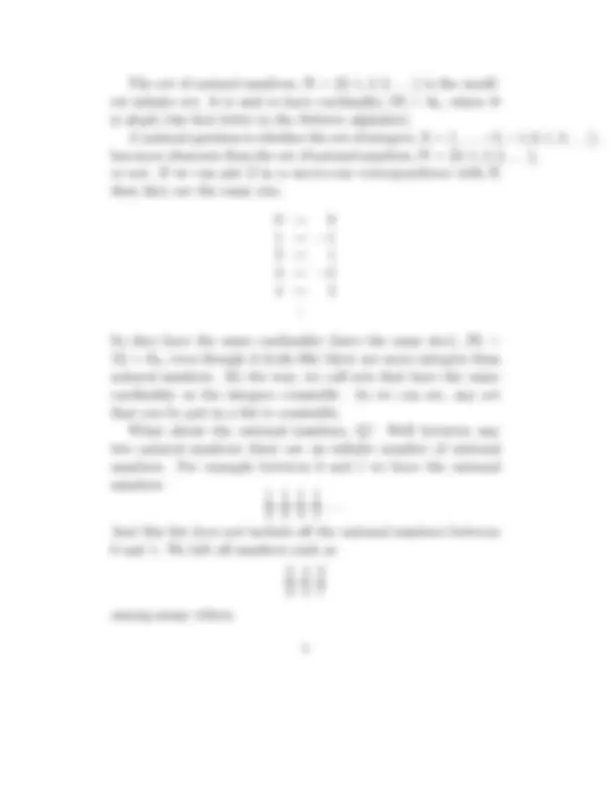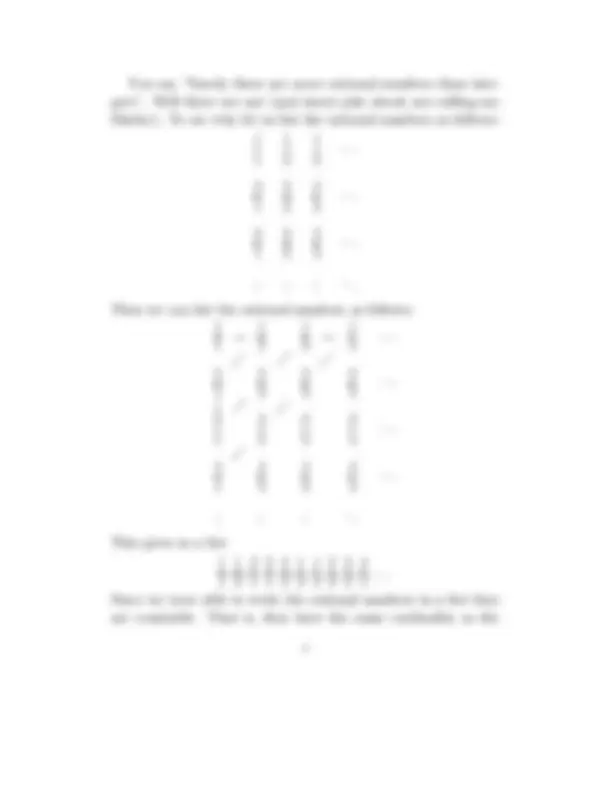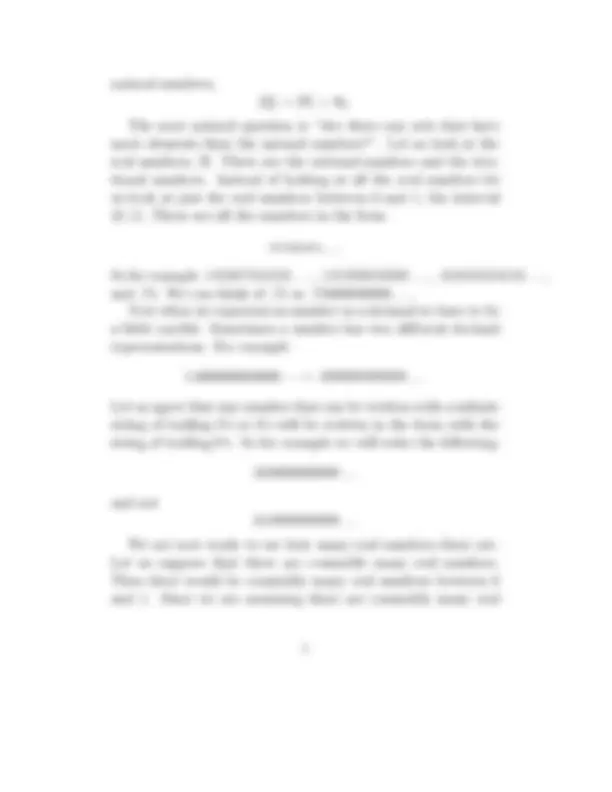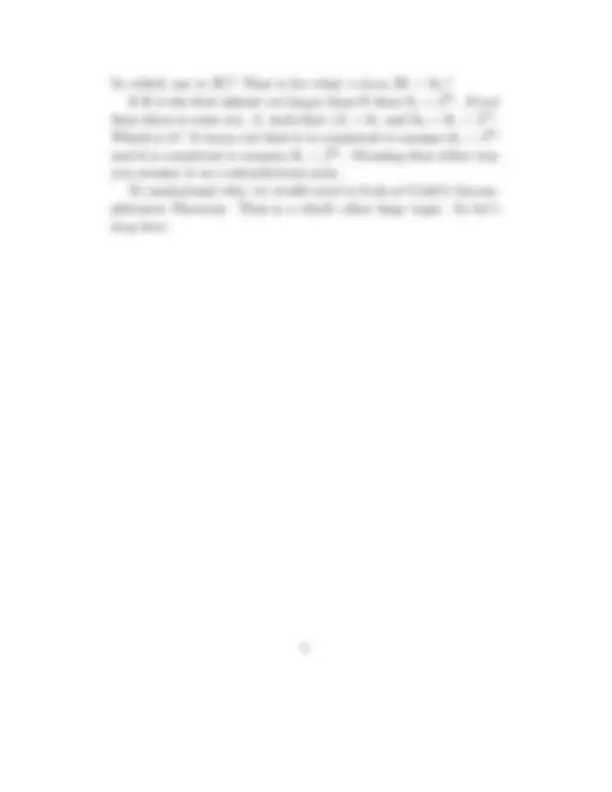






Study with the several resources on Docsity

Earn points by helping other students or get them with a premium plan


Prepare for your exams
Study with the several resources on Docsity

Earn points to download
Earn points by helping other students or get them with a premium plan
Community
Ask the community for help and clear up your study doubts
Discover the best universities in your country according to Docsity users
Free resources
Download our free guides on studying techniques, anxiety management strategies, and thesis advice from Docsity tutors
An introduction to infinite sets, focusing on the concepts of cardinality, subsets, and the continuum. The author explains how to determine the cardinality of a set by putting it into a one-to-one correspondence with an initial segment of the positive integers. The document also covers the definitions of a subset and a proper subset, and discusses the concept of infinite sets, such as the set of natural numbers and the set of real numbers.
Typology: Study notes
1 / 8

This page cannot be seen from the preview
Don't miss anything!





Daniel Eric Smith
September 13, 2007
How big is the set { 1 , 2 , 3 }? First we have to figure out what the question “How big is a set?” means. By “How big is a set?” we mean how many elements does it have. In the case of { 1 , 2 , 3 } its size is 3. Technically (meaning mathematically) the way we do this is we put the set in a one-to-one correspondence with a initial segment of the positive integers. So for { 1 , 2 , 3 }
1 → 1 2 → 2 3 → 3
We call the size of a set its cardinality. What is the cardinality of the set { 2 , 4 , 5 , 7 , 8 , 9 }? Again to find the cardinality of a set we put it into a one-to-one corre- spondence with an initial segment of the positive integers. So
1 → 2 2 → 4 3 → 5 4 → 7 5 → 8 6 → 9
So the cardinality of { 2 , 4 , 5 , 7 , 8 , 9 } is |{ 2 , 4 , 5 , 7 , 8 , 9 }| = 6. Recall
Definition 1 (Subset). The set A is a subset of the set B if every element of A is also an element of B, A ⊆ B.
So for example { 1 , 2 , 3 } ⊆ { 1 , 2 , 3 , 4 } since every element of { 1 , 2 , 3 } is also an element of { 1 , 2 , 3 , 4 }. It also turns out that by the definition of subset { 1 , 2 , 3 , 4 } ⊆ { 1 , 2 , 3 , 4 }. If the set B has an element that A does not have and A is a subset of B we call A a proper subset of B.
Definition 2 (Proper Subset). If A ⊆ B and there exists an element of B that is not in A we call A a proper subset of B, A ⊂ B.
So the set { 1 , 2 , 3 } is a proper subset of { 1 , 2 , 3 , 4 }, { 1 , 2 , 3 } ⊂ { 1 , 2 , 3 , 4 }, but { 1 , 2 , 3 , 4 } is not a proper subset of { 1 , 2 , 3 , 4 }. Now if A ⊂ B and B is finite then |A| < |B|. This makes sense because B has some element that A does not. Now lets look at the sets { 1 , 2 , 3 , 4 ,... } and { 2 , 4 , 6 , 8 ,... }. Clearly { 2 , 4 , 6 , 8 ,... } ⊂ { 1 , 2 , 3 , 4 ,... }.
But even though { 2 , 4 , 6 , 8 ,... } is a proper subset of { 1 , 2 , 3 , 4 ,... } they have the same number of elements.
1 → 2 2 → 4 3 → 6 4 → 8 ...
Definition 3 (Infinite Set). A set B is said to be infinite if A ⊂ B and |A| = |B|.
You say “Surely there are more rational numbers than inte- gers”. Well there are not (and insert joke about not calling me Shirley). To see why let us list the rational numbers as follows:
1 1
Then we can list the rational numbers as follows: 1 1
ւ ր ւ 2 1
↓ ր ւ 3 1
ւ 4 1
This gives us a list
1 1
Since we were able to write the rational numbers in a list they are countable. That is, they have the same cardinality as the
natural numbers, |Q| = |N| = ℵ 0. The next natural question is “Are there any sets that have more elements than the natural numbers?”. Let us look at the real numbers, R. These are the rational numbers and the irra- tional numbers. Instead of looking at all the real numbers let us look at just the real numbers between 0 and 1, the interval (0, 1). These are all the numbers in the form
.a 1 a 2 a 3 a 4...
So for example. 145287454125... ,. 141592653589... ,. 454545454545... , and .75. We can think of .75 as. 75000000000.... Now when we represent an number as a decimal we have to be a little careful. Sometimes a number has two different decimal representations. For example
Let us agree that any number that can be written with a infinite string of trailing 9’s or 0’s will be written in the form with the string of trailing 0’s. So for example we will write the following:
. 320000000000...
and not
. 319999999999... We are now ready to see how many real numbers there are. Let us suppose that there are countable many real numbers. Then there would be countably many real numbers between 0 and 1. Since we are assuming there are countably many real
Definition 4 (Power Set). The power set of A is the set of all its subsets. Denoted by P(A).
So the power set of { 1 , 2 } is
P({ 1 , 2 }) = {∅, { 1 }, { 2 }, { 1 , 2 }}.
And the power set of { 1 , 2 , 3 } is
P({ 1 , 2 , 3 }) = {∅, { 1 }, { 2 }, { 3 }, { 1 , 2 }, { 1 , 3 }, { 2 , 3 }, { 1 , 2 , 3 }}.
Note that |P({ 1 , 2 })| = 4 = 2^2 and |P({ 1 , 2 , 3 })| = 8 = 2^3. It can be shown that if |A| = n then |P(A)| = 2n. So for any non-empty finite set A we have |A| < |P(A)|. What about when A is not finite? Is |A| < |P(A)| when A 6 = ∅ (A is non-empty)? It can be proved that it is still true. In fact you can prove this by generalizing Cantor’s Diagonal Argument (which I am not going to show you since it gets a little tricky to do it). Since |N| = ℵ 0 we have ℵ 0 < 2 ℵ^0. Also 2 ℵ^0 < 22 ℵ 0
. We can continue this process and so we see that there are infinitely many different sizes of infinity. It can be shown that |R| = 2ℵ^0 =. So we can see that the number of elements a set can contain is
0 , 1 , 2 , 3 ,... , ℵ 0 , ℵ 1 , ℵ 2 ,...
So which one is |R|? That is for what n does |R| = ℵn? If R is the first infinite set larger than N then ℵ 1 = 2ℵ^0. If not then there is some set, A, such that |A| = ℵ 1 and ℵ 0 < ℵ 1 < 2 ℵ^0. Which is it? It turns out that it is consistent to assume ℵ 1 = 2ℵ^0 and it is consistent to assume ℵ 1 < 2 ℵ^0. Meaning that either way you assume it no contradictions arise. To understand why, we would need to look at G¨odel’s Incom- pleteness Theorem. That is a whole other huge topic. So let’s stop here.